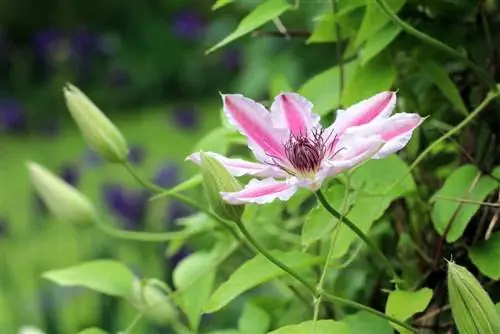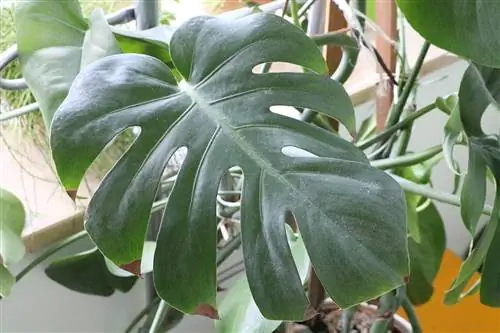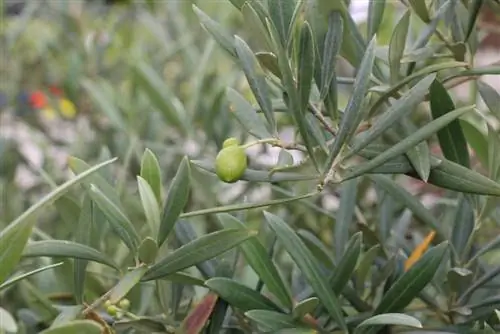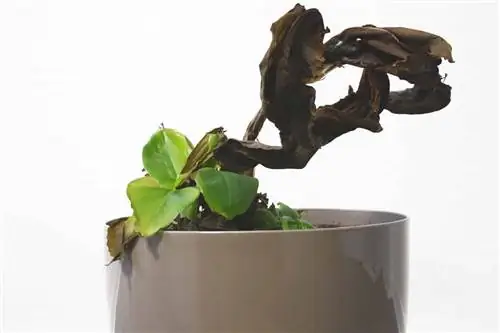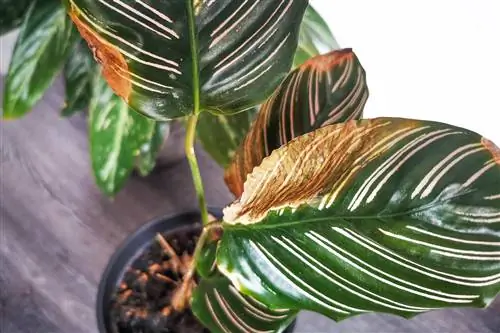- Author admin [email protected].
- Public 2023-12-17 03:39.
- Last modified 2025-01-24 12:45.
There are plant diseases and waiting doesn't help. Clematis wilt is such a treacherous fungal disease. As if out of the blue, she strikes quickly and mercilessly. Anyone who takes time to fight them has already lost the fight. It is therefore important to react quickly. The climbing artist should recover and continue to do her flourishing work. With the right measures, this request is by no means hopeless.
Clematis wilt, what is that exactly?
Clematis wilt is a disease caused by fungal pathogens. The spores of the fungi are already in the soil and are just waiting for an opportunity to attack the clematis plant. Open spaces caused by injuries are welcome entry points. After infecting the plant, they unfold their devastating effect without much delay and at a breathtaking pace. However, the name clematis wilt covers two different diseases. They are caused by different fungal pathogens and also differ in the later course of the disease. The two types are:
- Phoma wilt
- Fusarium wilt
It is important to differentiate and clearly identify these two species. The type of wilt has a significant influence on the approach to combating it.
The Phoma Wilt
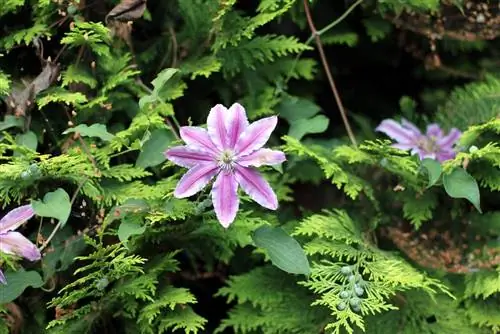
Phoma wilt is the most common wilt. The damage is similar to that of leaf spot disease. That's why it's crucial to take a second look at the diseased vine. Because while leaf spot is unsightly but still harmless, Phoma wilt must be taken seriously.
- The cause is the fungal pathogen Ascochyta clematidina
- first signs appear in May or June
- leaves close to the ground and older are affected first
- small, round and yellow-brown spots appear on undersides of leaves
- Spots become larger, darker and misshapen
- they spread further and further onto the leaves
- the affected leaves eventually die
- warm, humid climate favors the spread
The fungus also spreads in the shoots and stems, which of course cannot be seen with the naked eye.
Which clematis varieties are susceptible to Phoma wilt?
The original clematis varieties are not left out by Phoma wilt. However, the clinical picture is limited. Most of the time the disease does not progress beyond the stage of small spots. This course of the disease is harmless to the plant. But what about the numerous hybrid varieties? These are often found in our gardens because of their large and predominantly double flowers. Here the fungus usually completely destroys all parts above ground. Especially with these beautiful varieties, control is necessary so that the damage is minimized or the climbing plant is prevented from dying completely.
Discover Phoma wilt in good time
The wilt is spreading quickly. It takes barely two weeks from the first signs to the death of entire shoots. Rescue measures can only be effective in the early stages of the disease. It is therefore important to detect the infestation early. This should not be left to chance, otherwise any help could come too late for the clematis.
- Inspect the vine at regular intervals
- from mid-May in small intervals of a few days
- especially examine the older leaves in the lower third of the plant
Successfully combat Phoma wilt

As soon as the first signs of wilting appear on the clematis, action should be taken immediately.
- remove all wilted leaves immediately
- if necessary, entire shoots must also be cut off
- possibly pick up fallen leaves from the ground
- removed plant parts belong in the residual waste
- Parts of plants affected by fungus must under no circumstances be composted
- spray the cut back vine with commercial fungicide
Tip:
After cutting off diseased shoots, be sure to clean and disinfect the cutting tool used so that any fungal spores adhering to it are completely removed.
How quickly the climbing plant recovers depends on how advanced the disease was. If the fungus has not yet reached the inside of the plant, the clematis will recover quickly. Otherwise, the plant can often no longer be helped, even with fungicides. Sometimes it can happen that the clematis survives the complete death above ground. After about three years it will sprout again. If you want to experience such a positive surprise, you should leave the roots in the ground and not dig them up.
The Fusarium wilt
The less common Fusarium wilt, also known as fusiarose, is caused by a slime mold called Coniothyrium clematidis-rectae. It uses the smallest injuries on the plant to get into its conductive pathways from the outside. From there it spreads through the plant's supply system, clogging parts of it.
- Plant parts above the affected areas suffer
- they no longer get enough water
- nutrients no longer reach them either
- due to the lack of supply, they suddenly wilt and die
- Leaves initially have a brown edge
- Edge spreads further towards the center of the sheet
Which clematis are affected by Fusarium wilt?
Basically any clematis can suffer from this wilt. However, some clematis plants are particularly susceptible to this because they are not sufficiently resistant or offer an unprotected surface for attack. These are the following:
- large-flowered varieties
- young plants
- old clematis
- climbing plants weakened by care errors
- Plants with damage to their young shoots
Tip:
When gardening, be careful not to accidentally damage the plant. Since their tendrils are thin, they can be easily torn off.
Discover Fusarium wilt in good time
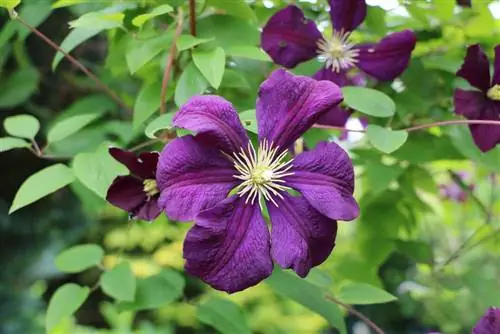
Even with this type of wilt, it is useful to detect its signs as early as possible through regular inspection. But unlike Phoma wilt, this disease occurs a little later. These fungal pathogens like warmer weather with temperatures above 20°.
- first signs can be expected from mid-June
- individual shoots that suddenly wilt for no apparent reason
Note:
Wilting shoots are quickly interpreted as a sign of a lack of water. The vine is then watered. However, if this is a result of Fusarium wilt, this watering will not bring any improvement. Valuable time is lost if action is not taken accordingly.
Successfully combat fusarium wilt
There are no effective fungicides available to combat Fusarium wilt. This makes it all the more important to use alternative control methods immediately. Here too, you have to consistently use secateurs. However, it is not enough to just remove the wilted parts of the plant.
- a radical cut is unavoidable
- all shoots must be cut off close to the ground
Note:
In order to avoid further infections, care must always be taken to thoroughly disinfect the equipment used when cutting diseased plant parts. Both before and after divorce.
So that the fungus cannot strike again, all above-ground parts must be completely and safely disposed of. The ground must also be searched for old, fallen leaves. The pathogen can still cling to them and they also have to be collected and destroyed. If the disease is discovered at an early stage, there is a good chance that the climbing plant will recover. Since the fungus does not penetrate the root area, new shoots can sprout from it after a while.
Successfully avoiding wilt
The best protection against both types of wilt is to prevent it from getting that far in the first place. The possibilities for successful prevention start with planting and continue with ongoing care. Plants that grow in a suitable location and receive optimal care are stronger and more resistant to this pathogen.
- only buy strong plants, in 2-3 liter containers
- the optimal location is protected from wind, rain and sun
- Plant root balls deeper
- Make sure there is enough distance when planting on walls
- always follow the care rules
- Drainage prevents waterlogging
- Never rake the soil, roots and shoots can be damaged
- water in the root area, never over the leaves
Choose resilient species
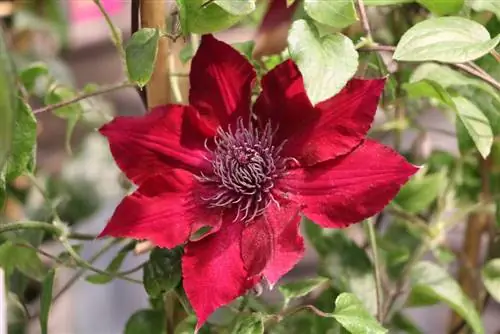
Some original clematis species have proven to be quite resilient. Many new breeds have also specifically focused on resistance. If you want to be on the safe side, you can use these varieties right from the start.
- original varieties from the Italian Clematis-Viticella group
- large-flowered hybrids such as spring-flowering 'Multi Blue' and 'The President'
- summer-flowering clematis: e.g. B: 'Comtesse de Bouchaud', 'Ville de Lyon' or 'Yukikomachi'

